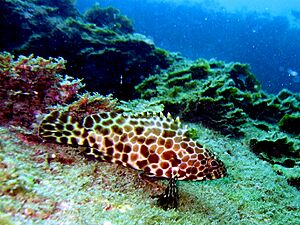Longfin grouper facts for kids
Quick facts for kids Longfin grouper |
|
|---|---|
 |
|
| Conservation status | |
| Scientific classification | |
| Synonyms | |
|
The longfin grouper (Epinephelus quoyanus), also known as the longfin rockcod or honeycomb rockcod, is a type of ray-finned fish that lives in the ocean. It's a kind of grouper, which belongs to the same family as sea basses. You can find it in the Western Pacific Ocean.
What it Looks Like
The longfin grouper has a body that's about 2.8 to 3.2 times as long as it is deep. Its head has a smooth, curved top. The dorsal fin (on its back) has 11 strong spines and 16-18 soft rays. The anal fin (on its belly) has 3 spines and 8 soft rays.
Its tail fin is rounded. The pectoral fins (on its sides, like arms) are about twice as long as its head. The fish is mostly whitish on its head, body, and fins. It has many large, dark brown to black spots that look like hexagons or circles.
On its upper head and body, the spots are closer together, forming a net-like pattern. On its lower head and body, the spots are more spread out and less clear. Its dorsal, anal, and tail fins also have similar dark spots.
It has two dark bands on its chest that meet under the pectoral fin. These bands almost join at the gill slit, leaving a pale patch on the lower part of the chest. There's another pale area between the upper dark band and a dark spot near the base of the pectoral fin.
The throat and lower chest have irregular dark brown bands and blotches. The dark spots on its head get smaller towards its snout. However, these spots are always bigger than its nostrils. There's a square-shaped white or pale area on its cheek, near the back of its upper jaw.
The back edges of its pectoral, anal, and tail fins are mostly dark with faint spots. The front edge of its pelvic fins has a white line and a wide, dark band. This fish can grow up to 40 centimetres (16 in) long.
Where it Lives
The longfin grouper lives in the Indo-West Pacific region, especially around the Indomalayan area. In the Indian Ocean, it has only been seen near the Andaman Islands and off Australia.
In the Western Pacific Ocean, its home stretches from Japan and South Korea in the north, all the way south to Australia. It also lives as far east as the Solomon Islands. In Australia, you can find it from Shark Bay in Western Australia along the northern coast. It also lives as far south as northern New South Wales, including the islands of the Great Barrier Reef.
Life and Habits
Longfin groupers live on silty reefs in coastal waters. They are usually found at depths of less than 50 metres (160 ft). They don't move around much and mostly stay in one place.
These fish eat worms, smaller fish, and crustaceans like crabs and shrimp. Longfin groupers are special because they are protogynous hermaphrodites. This means they are born female and later in life can change into males.
Females become ready to have babies when they are about 24 centimetres (9.4 in) long and around 1.8 years old. They change into males when they reach about 33 centimetres (13 in) in total length. Their long, fleshy pectoral fins seem to help them rest on the ocean floor.
Who Discovered It
The longfin grouper was first officially described in 1830. A French zoologist named Achille Valenciennes gave it the scientific name Serranus quoyanus. He named it after Jean René Constant Quoy, a French naval surgeon and zoologist who helped report this species.
How People Use It
The longfin grouper is somewhat important for fishing in places like Hong Kong and Taiwan. You can find it in live fish markets in Hong Kong and other parts of Southeast Asia.
Young longfin groupers are caught in the summer. Larger fish are caught using gill nets, hand-lines, and traps. Sometimes, young fish caught in the wild are raised in cages in Southeast Asia, but this is done on a small scale.


